Lockerbie bombing: The ultimate detective story?
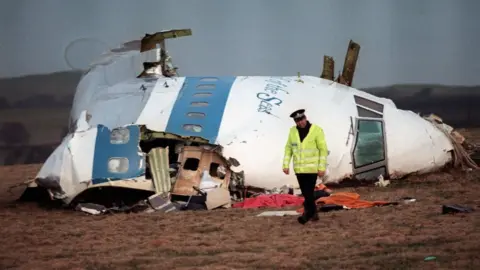 AFP
AFPThirty-five years ago this week the deadliest terror attack in British history took place when Pan Am flight 103 from London to New York exploded over the Scottish town of Lockerbie.

In a prison cell in the United States, 72-year-old Abu Agila Masud is waiting to stand trial, accused of making the bomb that destroyed the US airliner.
The prospect of the Libyan's trial has been accompanied by a renewed surge of interest in the events of 21 December 1988.
At its heart lies an atrocity which killed 270 men, women and children from 21 countries. Entire families died on the plane and on the ground.
An account of the investigation that followed reads like the ultimate true crime detective story.
Everyone on board Pan Am flight 103 that night was killed - 259 passengers and crew. The oldest was 82 while the youngest was a two-month-old baby.
Two thirds of the victims were Americans. It was the worst terror attack on the US until 9/11.
Another 11 people perished when the wreckage fell on their homes in Lockerbie. In total, 44 UK citizens were killed. It remains the worst act of mass murder in British legal history.
'You couldn't make this up'
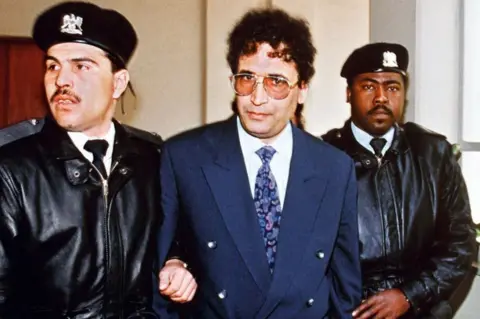 Getty Images
Getty ImagesThere will always be competing theories about who was responsible but only one version of events has been accepted by a court of law and upheld on appeal.
In 2001, a Scottish court sitting in the neutral Netherlands ruled it was an act of state-sponsored terrorism carried out by the Libyan intelligence service.
Three judges decided Abdelbaset al-Megrahi was part of the plot and convicted him of playing a central role in the bombing.
He became known as "the Lockerbie bomber" but he was always accused of acting along with other Libyan conspirators, including Abu Agila Masud, the man now facing trial in the US.
The case put before that court more than 20 years ago followed an international investigation that extended to 70 countries.
Almost every piece of key evidence has been debated and disputed, to the exasperation of the Scots and Americans who investigated Lockerbie.
Responding to accusations that Libya and Megrahi were framed, a former chief constable of Dumfries and Galloway Constabulary once declared: "You couldn't make this up. How on earth can you set up a chain of evidence like that? It's nonsense."
The story of that chain of evidence starts in the streets of Lockerbie and the surrounding countryside.
The world's biggest crime scene
 Reuters
ReutersThe Boeing 747 Clipper Maid of the Seas broke up at 31,000 feet as it flew from Heathrow to New York, four days before Christmas.
Approximately 319 tons of wreckage were scattered over 845 square miles - the largest crime scene in history.
A town that would normally have four police officers on duty found itself at the centre of a massive recovery operation and investigation.
By the morning of 22 December, about 1,100 police officers were involved, along with 1,000 personnel from the military, emergency services, local authorities and voluntary groups.
In the weeks that followed, a painstaking search recovered wreckage as far away as the coast of Northumberland on the other side of the country.
Investigators found signs of an explosion on one of the baggage containers from the forward hold.
Scottish police and FBI agents established the bomb had been concealed in a Toshiba radio cassette player in a Samsonsite suitcase.
 PA Wire
PA WireInitially, suspicion fell on Iran and a Syrian-backed Palestinian militant group.
On 3 July 1988, a US Navy cruiser USS Vincennes had mistakenly shot down an Iranian airliner over the Gulf, killing all 290 men, women and children on board. Iran swore revenge.
Three months before the Lockerbie bombing, in an operation titled Autumn Leaves, West German police had raided flats in Frankfurt and arrested members of the Syrian-backed Popular Front for Liberation of Palestine-General Command (PFLP-GC).
The group had been preparing bombs in radio cassette players. By December 1988, most had been released.
The feeder flight for Pan Am 103, Pan Am 103a, had left from Frankfurt.
Months were spent investigating the PFLP-GC group but the search for evidence then took the inquiry in a different direction - to an island in the Mediterranean.
The Maltese connection
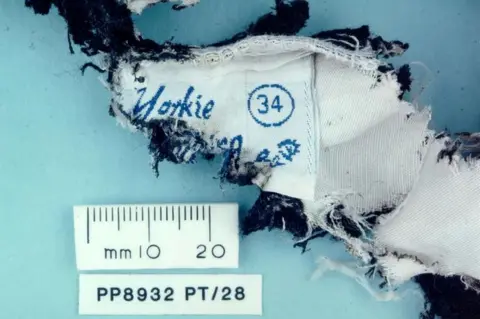 Crown Office
Crown OfficeA babygro from the suitcase containing the bomb had been made in Malta. Another charred fragment from a pair of trousers bore a Yorkie label. With the input of the FBI, the inquiry traced the Yorkie brand to a Maltese clothes manufacturer.
Scottish detectives visited the firm and were told Yorkie trousers had been sold to a small shop in a side street in Sliema.
The officers listened in astonishment when the owner of Mary's House recalled selling Yorkie trousers to a man in the weeks before the Lockerbie bombing.
It was an unusually lucrative piece of business Tony Gauci remembered well, even though it had happened nine months before.
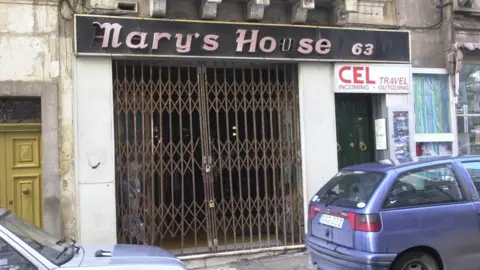 PA Media
PA MediaHe said the customer had bought a seemingly random collection of clothes and an umbrella.
Mr Gauci was certain he was Libyan and in February 1991, shown a photograph of Abdelbaset al-Megrahi supplied by the Czech intelligence service, he said it looked similar to the man who'd come into his shop.
His identification of Megrahi was never absolute but records showed the Libyan was on Malta on the date Mr Gauci was alleged to have sold him the clothes.
All of this was vigorously disputed at Megrahi's trial and has been ever since, but to this day that cornerstone of the prosecution case remains in place.
Fragment of a bomb timer
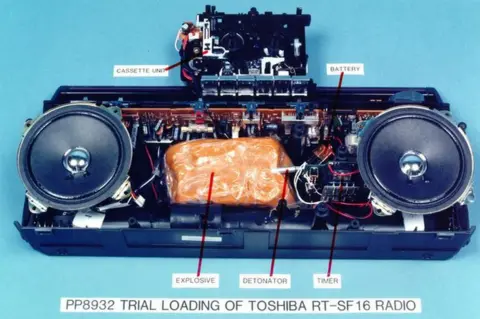 Crown Office
Crown OfficeIn January 1989, detectives searching near the countryside 30 miles from Lockerbie had found another scrap of cloth.
Embedded in the charred neckband of a shirt was a fragment of a green-coloured circuit board.
With the help of the CIA, the FBI matched it to MST-13 bomb timers which had been seized in the African country of Togo.
Then with the assistance of German police and the authorities in Switzerland, the trail led to a company called Mebo.
The first interviews with the company revealed it had sold MST-13 timers to Libya. One of its owners, Edwin Bollier, knew Megrahi, who had an office next to his in Zurich.
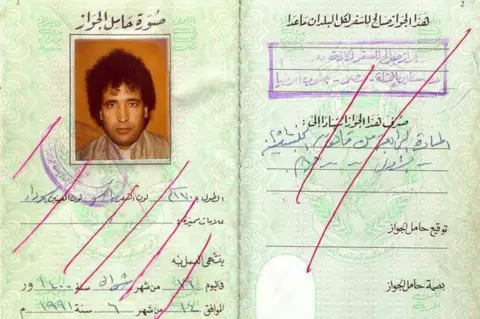 Crown Office
Crown OfficeBack in Malta, an exhaustive search of immigration records established Megrahi had arrived on the island from Libya on 20 December 1988, the day before the bombing, using a false passport supplied by the Libyan intelligence service.
He travelled back to Libya on the 21st, accompanied, it was alleged, by the suspect now in that American jail - Abu Agila Masud.
In November 1991, Scottish and American prosecutors announced charges which alleged that Megrahi and another Libyan, Al Amin Khalifa Fhimah, were members of their country's intelligence service.
Megrahi had been head of security at Libyan Arab Airlines. Fhimah was the former station manager for Libyan Arab Airlines at Luqa Airport on Malta.
They were accused of placing the suitcase containing the bomb into the luggage system at Luqa for a flight from Malta to Frankfurt.
Computer records printed off by a baggage handler at Frankfurt Airport after the bombing showed an unaccompanied suitcase had arrived on a flight from Malta and was loaded onto the feeder flight, Pan Am 103a.
The prosecution case was that it was transferred onto board Pan Am 103 at Heathrow.
The first Lockerbie trial
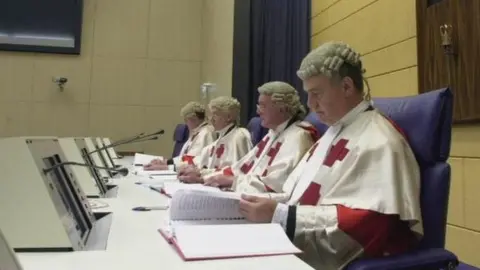 PA
PAInterviewed in Libya, Megrahi and Fhimah protested their innocence. Megrahi said he hadn't been in Malta on the day of the bombing but the fake passport proved otherwise.
Libya's leader Colonel Gaddafi refused to hand the men over.
Years of deadlock and sanctions followed, until the involvement of Nelson Mandela and a UN-brokered deal led to a trial in a Scottish court at Camp Zeist, a former US airbase in the Netherlands.
After 84 days of evidence, Fhimah was cleared. Megrahi was convicted of mass murder, lost his first appeal and was flown to Scotland to serve a life sentence.
Many relatives of the American victims were furious that Colonel Gaddafi had not been in the dock with the pair.
But some relatives of the British victims, led by the English GP Dr Jim Swire, believed and still believe that Megrahi was innocent, and the real culprits were Iran and the Palestinians.
In 2003, lawyers acting for the victims announced they had reached agreement with Libya over a £1.7bn compensation fund.
Libya accepted responsibility for the actions of its officials, although years later Colonel Gaddafi's son claimed it had only done so for sanctions to be lifted.
Doubts over the conviction
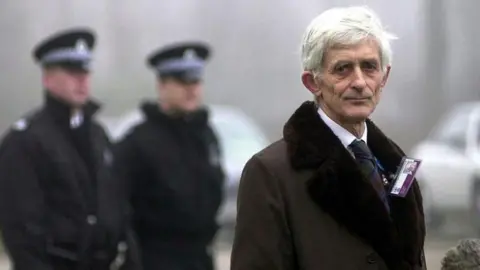 PA Media
PA MediaIn 2007, the Scottish Criminal Cases Review Commission referred the case back to the appeal court.
It said it had found nothing to suggest evidence had been tampered with - a longstanding accusation from Megrahi's supporters - but believed he might have been the victim of a miscarriage of justice, principally over Tony Gauci's identification of him as the man who bought the clothes for the suitcase that held the bomb.
The case was slowly working its way through the courts when Megrahi was diagnosed with terminal cancer in 2008.
He abandoned his second appeal in 2009 and was released on compassionate grounds by the Scottish government after doctors advised he had three months to live.
The decision was supported by Dr Swire and some of the other British relatives, but it is still the cause of great bitterness among many relatives of the American victims.
Megrahi outlived Colonel Gaddafi, who was killed after an uprising toppled his regime in 2011. The man called the Lockerbie bomber died in 2012, three years after his release.
New suspects
Gaddafi's demise gave investigators fresh hope that new light could be shed on Lockerbie. Contact was made with the new Libyan authorities and Scottish and American investigators and prosecutors travelled to North Africa to meet them.
In 2015, Scotland's Crown Office and the US Attorney General announced they had evidence to treat two Libyans as suspects and were requesting permission from Libya to interview them.
The suspects were Abu Agila Masud and Gaddafi's former intelligence chief Abdullah al-Senussi, who had picked up Megrahi at the airport in Tripoli when he arrived home from Scotland six years before.
What appeared to be a major development was derailed when Libya descended into civil war but lines of communication with Libyan officials were maintained despite the bloodshed and chaos.
A third appeal
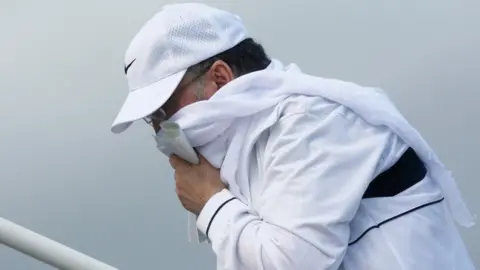 PA Media
PA MediaIn 2017, five years after his death, Megrahi's family lodged a new bid to clear his name.
It was being considered when Scotland's national police force announced the results of Operation Sandwood - an investigation into allegations from Megrahi's supporters.
Police Scotland said they had found no evidence of criminality in relation to the handling of the investigation and prosecution of the case.
What they had found was new information which they passed to the Crown Office and the Scottish Criminal Case Review Commission which was looking at the case a second time.
In 2020, the commission sent Megrahi's conviction back to the appeal court, having concluded that: "No reasonable trial court, relying on the evidence led at trial, could have held the case against Mr Megrahi was proved beyond reasonable doubt."
As ever with Lockerbie, it wasn't that simple.
The commission also said it had obtained new information which, if believed, pointed at Libya and Megrahi as being responsible for bombing Pan Am 103.
A cycle of retribution and revenge
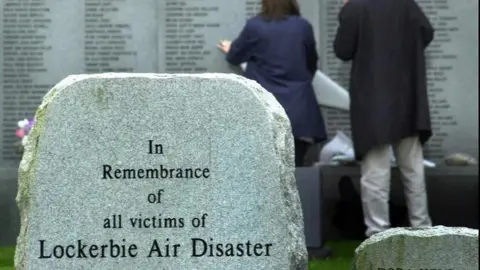 PA Media
PA MediaOn the 32nd anniversary of the bombing, the US announced charges against Abu Agila Masud, who was serving a jail sentence in Libya for targeting anti-Gaddafi forces back in 2011.
The FBI criminal complaint said Masud had confessed to making the bomb that brought down Pan Am 103, and had acted in concert with Megrahi and Fhimah, the Libyan cleared at Camp Zeist.
The Americans alleged Masud was an ex-Libyan intelligence operative and had admitted carrying out the attack on the orders of Colonel Gaddafi, who, he said, congratulated him afterwards.
Masud was also said to have admitted making the bomb used in an attack on a disco in Berlin in 1986.
American and Scottish investigators believe that was the incident that triggered the whole terrible cycle of retribution and revenge that led to Lockerbie.
Libya and the US were at loggerheads in the 1970s and 80s. The bombing at the La Belle disco killed two US servicemen and a Turkish woman, and injured another 229 people, 79 of them American.
The then US president Ronald Reagan said Libya was responsible and 10 days later, the US air force bombed the Libyan capital Tripoli and the city of Benghazi.
Widely seen as an attempt to assassinate Colonel Gaddafi, who survived, the operation killed his adopted baby daughter along with at least 15 civilians.
The bombing of Libya after the bombing of the disco has been put forward as the motive for the bombing of Pan Am 103.
Another theory is that Libya took on the "task" of avenging the shooting down of the Iranian airliner after the Palestinian cell was discovered in West Germany.
A month after the charges against Masud had been made public, Scottish judges rejected Megrahi's posthumous appeal and upheld the verdict delivered at Camp Zeist 20 years earlier.
Will there be another trial?
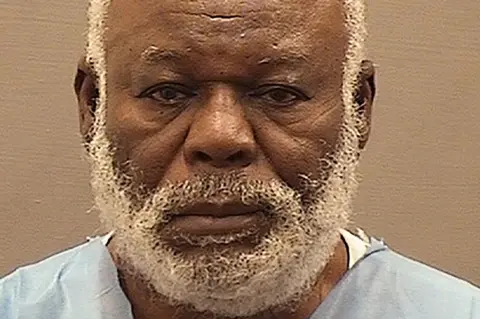 Reuters
ReutersIn December 2022, a few weeks before the 34th anniversary of the bombing, came the news that Masud had been handed over to American custody.
The exact circumstances have not yet been explained but the head of Scotland's prosecution service has said the process was lawful.
Masud's family claimed he had been dragged from his sick bed by armed militia and was a religious man who wouldn't kill anyone.
Named in court papers as Abu Agila Mohammad Mas'ud Kheir Al-Marimi, the Libyan has pled not guilty to two counts of destruction of an aircraft resulting in death and a count of destruction of a vehicle resulting in death.
Assuming his trial goes ahead, the case built by Scottish and American investigators over decades will be put before a jury in a US federal court.
The provenance of the alleged confession is sure to be contested by the defence.
Will the trial happen? Masud is a long way from home and facing the possibility of ending his days in a foreign jail.
If he does know what happened at Lockerbie, would it be in his interests to co-operate with the US authorities?
As for Gaddafi's former spy chief, Abdullah Senussi, he's still alive in Libya.
The prospect of him ever standing trial over Lockerbie seems far-fetched, but this case has a long history of unexpected twists and turns.
Thirty-five years on, there are more chapters in this story to come.
